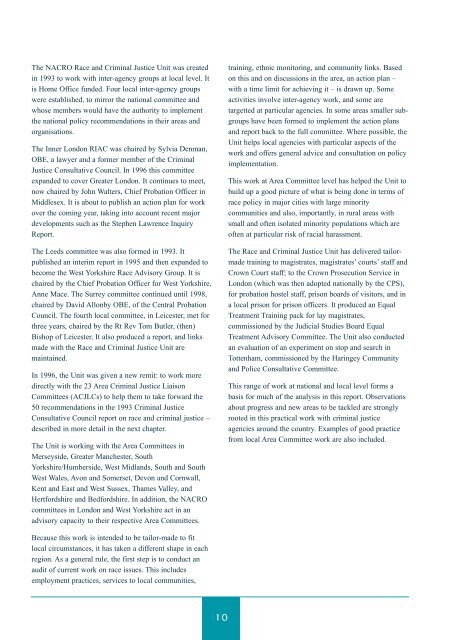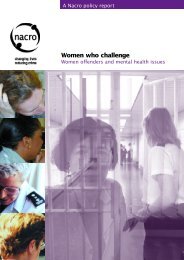Let's get it right: race and justice 2000 - Nacro
Let's get it right: race and justice 2000 - Nacro
Let's get it right: race and justice 2000 - Nacro
- No tags were found...
Create successful ePaper yourself
Turn your PDF publications into a flip-book with our unique Google optimized e-Paper software.
The NACRO Race <strong>and</strong> Criminal Justice Un<strong>it</strong> was createdin 1993 to work w<strong>it</strong>h inter-agency groups at local level. Itis Home Office funded. Four local inter-agency groupswere established, to mirror the national comm<strong>it</strong>tee <strong>and</strong>whose members would have the author<strong>it</strong>y to implementthe national policy recommendations in their areas <strong>and</strong>organisations.The Inner London RIAC was chaired by Sylvia Denman,OBE, a lawyer <strong>and</strong> a former member of the CriminalJustice Consultative Council. In 1996 this comm<strong>it</strong>teeexp<strong>and</strong>ed to cover Greater London. It continues to meet,now chaired by John Walters, Chief Probation Officer inMiddlesex. It is about to publish an action plan for workover the coming year, taking into account recent majordevelopments such as the Stephen Lawrence InquiryReport.The Leeds comm<strong>it</strong>tee was also formed in 1993. Itpublished an interim report in 1995 <strong>and</strong> then exp<strong>and</strong>ed tobecome the West Yorkshire Race Advisory Group. It ischaired by the Chief Probation Officer for West Yorkshire,Anne Mace. The Surrey comm<strong>it</strong>tee continued until 1998,chaired by David Allonby OBE, of the Central ProbationCouncil. The fourth local comm<strong>it</strong>tee, in Leicester, met forthree years, chaired by the Rt Rev Tom Butler, (then)Bishop of Leicester. It also produced a report, <strong>and</strong> linksmade w<strong>it</strong>h the Race <strong>and</strong> Criminal Justice Un<strong>it</strong> aremaintained.In 1996, the Un<strong>it</strong> was given a new rem<strong>it</strong>: to work moredirectly w<strong>it</strong>h the 23 Area Criminal Justice LiaisonComm<strong>it</strong>tees (ACJLCs) to help them to take forward the50 recommendations in the 1993 Criminal JusticeConsultative Council report on <strong>race</strong> <strong>and</strong> criminal <strong>justice</strong> –described in more detail in the next chapter.The Un<strong>it</strong> is working w<strong>it</strong>h the Area Comm<strong>it</strong>tees inMerseyside, Greater Manchester, SouthYorkshire/Humberside, West Midl<strong>and</strong>s, South <strong>and</strong> SouthWest Wales, Avon <strong>and</strong> Somerset, Devon <strong>and</strong> Cornwall,Kent <strong>and</strong> East <strong>and</strong> West Sussex, Thames Valley, <strong>and</strong>Hertfordshire <strong>and</strong> Bedfordshire. In add<strong>it</strong>ion, the NACROcomm<strong>it</strong>tees in London <strong>and</strong> West Yorkshire act in anadvisory capac<strong>it</strong>y to their respective Area Comm<strong>it</strong>tees.training, ethnic mon<strong>it</strong>oring, <strong>and</strong> commun<strong>it</strong>y links. Basedon this <strong>and</strong> on discussions in the area, an action plan –w<strong>it</strong>h a time lim<strong>it</strong> for achieving <strong>it</strong> – is drawn up. Someactiv<strong>it</strong>ies involve inter-agency work, <strong>and</strong> some aretar<strong>get</strong>ted at particular agencies. In some areas smaller subgroupshave been formed to implement the action plans<strong>and</strong> report back to the full comm<strong>it</strong>tee. Where possible, theUn<strong>it</strong> helps local agencies w<strong>it</strong>h particular aspects of thework <strong>and</strong> offers general advice <strong>and</strong> consultation on policyimplementation.This work at Area Comm<strong>it</strong>tee level has helped the Un<strong>it</strong> tobuild up a good picture of what is being done in terms of<strong>race</strong> policy in major c<strong>it</strong>ies w<strong>it</strong>h large minor<strong>it</strong>ycommun<strong>it</strong>ies <strong>and</strong> also, importantly, in rural areas w<strong>it</strong>hsmall <strong>and</strong> often isolated minor<strong>it</strong>y populations which areoften at particular risk of racial harassment.The Race <strong>and</strong> Criminal Justice Un<strong>it</strong> has delivered tailormadetraining to magistrates, magistrates’ courts’ staff <strong>and</strong>Crown Court staff; to the Crown Prosecution Service inLondon (which was then adopted nationally by the CPS),for probation hostel staff, prison boards of vis<strong>it</strong>ors, <strong>and</strong> ina local prison for prison officers. It produced an EqualTreatment Training pack for lay magistrates,commissioned by the Judicial Studies Board EqualTreatment Advisory Comm<strong>it</strong>tee. The Un<strong>it</strong> also conductedan evaluation of an experiment on stop <strong>and</strong> search inTottenham, commissioned by the Haringey Commun<strong>it</strong>y<strong>and</strong> Police Consultative Comm<strong>it</strong>tee.This range of work at national <strong>and</strong> local level forms abasis for much of the analysis in this report. Observationsabout progress <strong>and</strong> new areas to be tackled are stronglyrooted in this practical work w<strong>it</strong>h criminal <strong>justice</strong>agencies around the country. Examples of good practicefrom local Area Comm<strong>it</strong>tee work are also included.Because this work is intended to be tailor-made to f<strong>it</strong>local circumstances, <strong>it</strong> has taken a different shape in eachregion. As a general rule, the first step is to conduct anaud<strong>it</strong> of current work on <strong>race</strong> issues. This includesemployment practices, services to local commun<strong>it</strong>ies,10

















